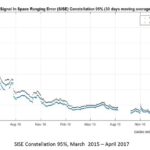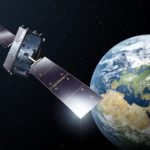Through its McMurdo brand, Orolia announced its global aeronautical distress safety system (GADSS)-compliant distress tracking emergency locator transmitter (ELT–DT). The product, known as the GADSS ELT–DT, performs autonomous tracking of commercial aircraft in distress through processes such as trigger-in-flight capability. This allows for the beacon to automatically transmit a distress signal with the aircraft’s accurate position. Read more…
Monthly Archives: July 2017
Problem behind failing clocks identified
Investigators have uncovered the problems behind the failure of atomic clocks onboard Galileo satellites, the European Commission said.
For months, the European Space Agency has been investigating the reasons behind failing clocks onboard some of the 18 Galileo navigation satellites.
Each Galileo satellite has four ultra-accurate atomic timekeepers, two that use rubidium and two hydrogen maser. But a satellite needs just one working clock for the satnav to wor, the rest are spares. Read more…
Another eight Galileo satellites for Europe
Europe’s Galileo navigation constellation will gain an additional eight satellites, bringing it to completion, thanks to a contract signed at the Paris Air and Space Show.
The contract to build and test another eight Galileo satellites was awarded to a consortium led by prime contractor OHB, with Surrey Satellite Technology Ltd overseeing their navigation platforms.
This is the third such satellite signing: the first four In Orbit Validation satellites were built by a consortium led by Airbus Defence and Space, while production of the next 22 Full Operational Capability (FOC) satellites was led by OHB.
These new batch satellites are based on the already qualified design of the previous Galileo FOC satellites, except for changes on the unit level – such as improvements based on lessons learned and reacting to obsolescence of parts.
Galileo provides healthy signals 97.33 percent of the time
Europe’s Galileo satellite navigation system has undergone its first performance report since it started work at the end of last year, and it passed with flying colors.
The European GNSS Agency, GSA has published the first of its regular quarterly performance reports on Galileo. This European GNSS (Galileo) Initial Services Open Service report, now available online, covers the first three months of 2017 and documents the good performance of Galileo Initial Services to date.
The report shows the 11 satellites then operating in the Galileo constellation were able to provide healthy signals 97.33 percent of the time on a per satellite basis, with a ranging accuracy better than 1.07 m and disseminating global UTC time within its signal to within 30 billionths of a second on a 95 percentile monthly basis. Read more…
First GNSS IS OS quarterly performance report now available

Following the Declaration of Initial Services in December 2016, the GSA will publish a new Galileo IS OS report after each quarter. These quarterly reports aim to provide the public with the latest information on the Galileo Open Service’s performance. Read more…
Two More Satellites Formally Added to Galileo’s Satnav System
Two further satellites, GSAT0207 (SV ID 07) and GSAT0214 (SV ID 05), increasing the total number to 16, have formally become part of Europe’s Galileo satnav system, broadcasting timing and navigation signals worldwide while also picking up distress calls across the planet.
These are the 15th and 16th satellites to join the network, two of the four Galileos that were launched together by Ariane 5 last November (images), and the first additions to the working constellation since the start of Galileo Initial Services in December. Read more…




